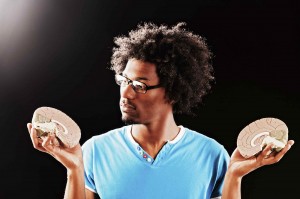Thinking About Thinking

Thinking about my thinking.
Let’s say your sweetie is feeling anxious or stressed or blue or just plain cranky. Would you help her?
Of course, you would. You might start by asking simple, straightforward questions, like: What’s going on? Why are you feeling down? How can I help? Simple, direct questions are effective because they’re thought provoking. They can cover a lot of mental territory. Ambiguous questions help as well. They allow your sweetie to frame her response based on her needs, not yours.
Now, let’s change the frame. If you were feeling anxious or stressed or blue or just plain cranky, would you ask yourself the same questions? I’ve asked this of many people and the most common response seems to be: I don’t think I would think of doing that.
The trick here seems to be the ability to convert a monologue into a dialogue. We all have a little narrator in our heads who comments on what’s going on around us. I call mine the play-by-play announcer because he (she? it?) serves the same function as a sports announcer – narrating the action.
When I watch a sporting event on TV, I just want the narrator to explain what’s going on and why. I want the same of my internal narrator. I don’t normally question the sports narrator; I just go with the flow. I do the same with my internal narrator.
The narrator – whether sports or internal – is in a monologue. It takes an act of imagination to question the narrator. When I’m speaking to my sweetie, it’s natural and obvious to create a dialogue. When I’m speaking to myself, it’s not at all obvious. I don’t naturally think about my thinking.
I’m trying to change that. I’m trying to teach myself a new trick. When I notice certain cues, I ask myself simple, direct questions to better understand the experience. What are the cues? There are at least three clusters:
Cue 1 — when I’m feeling anxious or stressed or blue or just plain cranky. I’ve learned to take note of this condition and use it as a prompt to ask a simple question: Why am I feeling this way? This helps me bring my feelings and desires to a conscious level and sort them out logically. In Daniel Kahneman’s terminology, I’m using my System 2 to check on my System 1.
Cue 2 – when I’m feeling really good, energetic, or enthusiastic. I’d like to feel this way more often. So, when I’m in a great mood, I prompt myself to ask: How did this happen? I’ve discovered some interesting correlations – not all of which I’m going to share. The best correlation may be obvious: Suellen is often around.
Cue 3 – when I have a good idea. I like having good ideas. I feel productive, creative, and smart. So, when I have a good idea, I prompt myself to ask: What was I doing when this idea popped into my head? Again, I’ve discovered some interesting correlations. Most frequently, I’m moving rather than sitting still. I don’t know why that is but I know it works.
I could probably apply the same introspection to other cues as well. At the moment however, I’m just trying to master the trick under these three conditions. What about you? When do you think about your thinking?
Mind and Body

Happy Girl
How much does your body affect your brain? A lot more than we might have guessed even just a few years ago. The general concept — known as embodied cognition – holds that the body and the brain are one system, not two. (Sorry, Descartes). What the body is doing affects what the brain is thinking.
I’ve written about embodied cognition before (here and here). Recently, I’ve seen a spate of new stories that extend our understanding. Here’s a summary:
The power pose – want to perform better in an upcoming job interview? Just before the interview, strike a power pose for two minutes. Your testosterone will go up and your cortisol will go down. You’ll be more confident and assertive and knock ’em dead in the interview. Amy Cuddy explains it all in the second most-watched TED video ever.
Willpower, dissension, and glucose – If you run ten miles, you’ll deplete your energy reserves. You may need to relax and refuel before taking up a new physical challenge. Does the same thing happen with willpower? Apparently so. If you resist the temptation to smoke a cigarette, you’ll have less willpower left to resist eating a donut. You can use up willpower just like you use up physical power. Perhaps that’s why you’re more likely to argue with your spouse when your glucose levels are low. If you sip a glass of lemonade, you might just avoid the argument altogether.
Musicians have better memories – experiments at the University of Texas suggest that professional musicians have better short- and long-term memories than the rest of us. For short-term memory (working memory), the musicians are better at both verbal and pictorial recall. For long-term memory, they’re better at pictorial recall. Maybe we should invest more in musical education.
How you walk affects your mood – as the Scientific American points out, “A good mood may put a spring in your step. But the opposite can work too: purposefully putting a spring in your step can improve your mood.” As Science Daily points out, the opposite is also true. If you walk with slumped shoulders and head down, you’ll eventually get grumpy. Your Mom was right: standing up straight actually does affect your mood and performance.
Intuition may just be your body talking to you – when you get nervous, your palms may start to sweat. Your mood is affecting your body, right? Well, maybe it’s the other way round. Your intuition (also known as System 1) senses that something is amiss. It needs to get your (System 2) attention somehow. What’s the best way? How about sweaty palms and a racing heartbeat? They’re simple, effective signaling techniques that are hard to ignore.
The power of a pencil – want to get happy? Hold a pencil in your mouth like the woman in the picture. Your facial muscles act as if they’re smiling. You may consciously realize that you’re not smiling but it doesn’t really matter – your body is doing the thinking for you.
Two Brains. So What?

Alas, poor System 1…
We have two different thinking systems in our brain, often called System 1 and System 2. System 1 is fast and automatic and makes up to 95% of our decisions. System 2 is a slow energy hog that allows us to think through issues consciously. When we think of thinking, we’re thinking of System 2.
You might ask: Why would this matter to anyone other than neuroscientists? It’s interesting to know but does it have any practical impact? Well, here are some things that we might want to change based on the dual-brain idea.
Economic theory – our classic economic theories depend on the notion of rational people making rational decisions. As Daniel Kahneman points out, that’s not the way the world works. For instance, our loss aversion bias pushes us towards non-rational investment decisions. (See also here). It happens all the time and has created a whole new school of thought called behavioral economics (and a Nobel prize for Kahneman).
Intelligence testing – System 1 makes up to 95% of our decisions but our classic IQ tests focus exclusively on System 2. That doesn’t make sense. We need new tests that incorporate rationality as well as intelligence.
Advertising – we often measure the effectiveness of advertising through awareness tests. Yet System 1 operates below the threshold of awareness. We can know things without knowing that we know them. As Peter Steidl points out, if we make 95% of our decisions in System 1, doesn’t it also follow that we make (roughly) 95% of our purchase decisions in System 1? Branding should focus on our habits and memory rather than our awareness.
Habits (both good and bad) – we know that we shouldn’t procrastinate (or smoke or eat too much, etc.). We know that in System 2, our conscious self. But System 2 doesn’t control our habits; System 1 does. In fact, John Arden calls System 1 the habitual brain. If we want to change our bad habits (or reinforce our goods ones), we need to change the habits and rules stored in System 1. How do we do that? Largely by changing our memories.
Judgment, probability, and public policy – As Daniel Kahneman points out, humans are naturally good at grammar but awful at statistics. We create our mental models in System 1, not System 2. How frequently does something happen? We estimate probability based on how easy it is to retrieve memories. What kinds of memories are easy to retrieve? Any memory that’s especially vivid or scary. Thus, we overestimate the probability of violent crime and underestimate the probability of good deeds. We make policy decisions and public investments based on erroneous – but deeply held – predictions.
Less logic, louder voice – people who aren’t very good at something tend to overestimate their skills. It’s the Dunning-Kruger effect – people don’t recognize their own ineptitude. It’s an artifact of System 1. Experts will often craft their conclusions very carefully with many caveats and warnings. Non-experts don’t know that their expertise is limited; they simply assume that they’re right. Thus, they often speak more loudly. It’s the old saying: “He’s seldom right but never in doubt”.
Teaching critical thinking – I’ve read nearly two-dozen textbooks on critical thinking. None of them give more than a passing remark or two on the essential differences between System 1 and System 2. They focus exclusively on our conscious selves: System 2. In other words, they focus on how we make five per cent of our decisions. It’s time to re-think the way we teach thinking.
How We Think And What It Means

Let’s think about this.
We have not one but two thinking systems in our heads. Daniel Kahneman, a Nobel laureate in economics, dubs them System 1 and System 2. System 1 is fast, automatic, energy efficient, subconscious, and always on. We don’t think about it; it thinks for us. Some observers claim that System 1 makes 95% of our decisions. We merrily mosey along, not even aware that we’re making decisions.
We are, on the other hand, aware of System 2. When we think about thinking, we’re thinking about System 2. It’s our conscious self. It’s where we consider ideas, weigh evidence, and reach conclusions. Unfortunately, System 2 is an energy hog so we use it sparingly. Like other forms of exercise, System 2 requires effort, practice, and discipline. It’s hard.
We get by most of the time on System 1. Usually that’s fine – System 1 makes a lot of good decisions. But not all the time. System 1 produces biases like stereotyping, temporizing, risk aversion, and unbridled fear. If we don’t have an effective, well-tuned System 2 to overcome those biases, we can do a lot of damage to ourselves and others.
Maria Konnikova (pictured), in her lovely book, Mastermind: How To Think Like Sherlock Holmes, compares System 1 to Watson and System 2 to Holmes. System Watson represents “…our naïve selves, operating by the lazy thought habits … that we’ve spent our whole lives acquiring….” On the other hand, System Holmes, represents “… our aspirational selves, the selves that we’ll be once we’re done learning how to apply his method of thinking to our everyday lives and, in so doing break the habits of our Watson system once and for all.”
System Watson comes to us naturally. System Holmes needs to be learned, practiced, and mastered. As Konnikova notes, “…to break from that autopiloted [Watson] mode, we have to be motivated to think in a mindful, present fashion, to exert effort on what goes through our heads instead of going with the flow.”
David Brooks, in the Social Animal: The Hidden Sources of Love, Character, and Achievement, describes our bias towards the conscious mind (System 2): “The conscious mind writes the autobiography of our species. Unaware of what is going on deep down inside, the conscious mind assigns itself the starring role. It gives itself credit for performing all sorts of tasks it doesn’t really control.”
Brooks compares the conscious mind to ”… a general atop a platform, who sees the world from a distance and analyzes things linearly and linguistically….” The unconscious mind, “…is like a million little scouts [that] … careen across the landscape, sending back a constant flow of signals and generating instant responses. They maintain no distance from the environment, but are immersed in it. They scurry about, interpenetrating other minds, landscapes, and ideas.”
For Brooks, the individual is the star in the “outer mind”. In contrast, “… the inner mind highlights the power of relationships and the invisible bonds between people. If the outer mind hungers for status, money, and applause, the inner mind hungers for harmony and connection….”
From Kahneman, we learn about the native biases of System 1 and an important implication: we’re not rational when it comes to economic matters. This is the insight that won the Nobel Prize. From Konnikova, we learn how to observe and deduce. The implication: with sufficient motivation, we can indeed learn to overcome our biases. From Brooks, we learn that System 2 is an individualist while System 1 is a collectivist. The implication: this duality is an important source of tension in the body politic.
What else can we learn by comparing System 1 to System 2? Let’s talk more about that tomorrow.
Should You Trust Your Gut?

Gut Feel
When my students in critical thinking start to separate logic from emotion, they often say things like:
“I used to get tangled up between thinking and feeling. I now realize that I should ignore my feelings.”
“Emotions don’t help me think clearly. I’m not going to pay attention to them any more.”
These students have swung from one end of the pendulum to the other. On one end, thoughts and emotions are indeed tangled up. On the other end, thought reigns supreme; emotion is banished. Is that good? Should we really ignore our emotions?
Actually, no. Our emotions tell us something. They may warn us of dangers that we’re not aware of consciously. They may also be flat out wrong. It’s a System 1 issue. We use shortcuts – heuristics — to get quick answers. Many times those shortcuts produce the right answer. Sometimes they don’t. Wisdom is knowing the difference.
Here’s my advice on when you probably should and probably shouldn’t pay attention to your emotions:
Probably should – when something feels wrong, but you’re not sure what. You feel ill at ease with a new acquaintance but you don’t know why. You’re thinking about investing in a company that seems to have good prospects, but something feels wrong.
Your System 1 is always scanning the environment, alerting your subconscious to useful (and not so useful) information. It spots the pothole and guides your foot around it. It may also spot “potholes” in that company with good prospects or in your new acquaintance.
In situations like these, it’s good idea to step back, look around, and switch on all your observational tools. Above all, slow things down. Your System 1 is warning you that something needs further investigation. It’s a good idea to investigate.
Remember, however, that your System 1 can be overly protective. It doesn’t like novelty. It’s crotchety. It doesn’t particularly like strangers – especially if they look or act or talk differently. If you always listen to System 1 warnings, you’ll miss out on a lot of interesting people and adventures. So, when System 1 tells you to investigate further, it’s a good idea to do exactly that. But keep an open mind.
Maybe/maybe not – retrospective dot connection. We all make up stories about why things happened in the past. I can tell you a very clearheaded story of how and why my career evolved just as it did. For the most part, I’ll be wrong.
We find it very hard to accept that things might happen randomly. Perhaps there’s no rhyme or reason to it at all. That’s emotionally unsatisfying. It means we have no control. So we make up stories that seem logical but may be completely untrue. It’s called confabulation.
Unfortunately, we don’t realize that we’re doing it. The story sounds logical so we assume it’s true. We assume that the little model of reality that we build in our heads accurately reflects the reality that’s “out there”. We also assume that other people have the same view of reality. It’s not true.
It’s hard not to build stories. You’ll probably continue to do it. Just be aware that you’re doing it and that your stories are (probably) wrong.
Probably not – anything statistical. As Daniel Kahneman and others have pointed out, we’re naturally terrible at statistics, even if we’re trained at it. We assume that there are patterns where there are none. We assume that we can predict future outcomes based on past performance. We can’t.
So, if your intuition tells you that the number 24 is “due” to come up on the roulette wheel – it hasn’t been seen in over an hour – just ignore it. You’re wrong, you’re a lousy statistician, and you always will be.